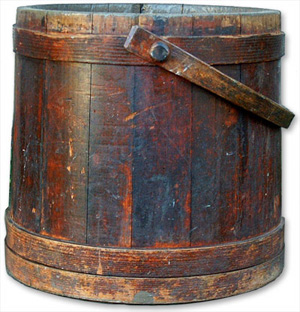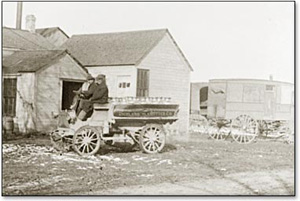Butter Glossary: A Glossary Of The Different Butter TypesThe History Of Butter This is Page 8 of an 8-page article. Click on the red links below to visit other pages. This glossary is protected by copyright and cannot be reproduced in whole or part. You are welcome to link to it.
|
 Our “party butter”: add softened butter to a ramekin, score the top and garnish with a rosemary crown. Photo by Claire Freierman | THE NIBBLE. |
|
|
The History Of Butter From Prehistory to Our History
This article is a digest of highlights selected by THE NIBBLE from an extensive historical perspective of butter that you can enjoy at WebExhibits.org. Butter is a culinary treasure as old as King Tut’s tomb and is mentioned throughout the Bible: “She brought forth butter in a lordly dish” (Judges 5:25). Butter is produced today essentially as it was in King Tut’s time—milk must be churned, although today our processes are mechanized instead of churned in goat skins swung from tent poles; and the butter we enjoy is made of milk from cows instead of camels or water buffaloes. Take this journey through the history of butter and see how many, many generations of your ancestors dealt with acquiring this golden necessity. |
||
|
The History of Butter
The word butter comes from bou-tyron, which means “cow cheese” in Greek. Recorded use of butter dates to 2,000 years before Christ. The Bible is interspersed with references to butter. Butter was the only food ever defined by an act of the U.S. Congress prior to the enactment of the Food, Drug and Cosmetic Act of 1938.
|
 |
|
|
The Holy Trinity by Andrei Rublev. ca. 1410-20. According to The Book of Genesis: “When Abraham was on the plains of Mamre, he entertained the three angels who appeared unto him as men as he sat in his tent. He said to Sarah to take three measures of meal and knead it quickly and make cakes upon the hearth; and it is said that he went to the herd and fetched a calf, tender and good, and gave it to be dressed, and he took butter and milk and the calf which he had dressed and set it before them and they did eat.”
We may think of garlic butter as an Italian treat, but some of the commonest archaeological finds in Ireland are barrels of ancient garlic butter, buried in peat bogs in wooden firkins (the Norse, Finns, Icelanders, and the Scots did the same). The longer it was left, the more delicious it became. Specimens have been found dating back to the 11th century, some of which weighed over 100 pounds. The Emergence of Dairy Butter
|
 |
|
|
A firkin from the1800’s. Butter is often discovered packed and buried in these small, wooden casks.
As nations grew and communities evolved, many families procured their milk and butter from local farmers. It was still the domain of women: the farmers’ wives. Commercial farm production of butter began to assume definite shape at least as early as 1791. “Dairy butter,” as it was called, was often collected as “pats,” “balls,” “rolls” and “prints.” Butter stamps and molds, carved in various styles and patterns, were used in dairies to decorate blocks or rounds of butter. As the demand increased, small shipments of butter from the dairies established on farms began to flow into towns and villages by horse and wagon, some families thus being directly supplied. Richland Diary wagon ca. 1907-1937.
|
 |
|
|
In the late 19th century, butter was often formed into half-pound or pound rounds or squares and stamped with an emblem, such as a sheaf of wheat, a cow, a beehive, or the maker’s initials. Then it was set aside in a cold place to thoroughly harden—generally in a tray in the spring-house water. When ready to market, each piece was wrapped in a linen cloth. For economy, over the years, freshly-laundered cloth rags and cheesecloth were used to wrap the butter. In the 1880’s and 1890’s, paraffin paper, and later vegetable parchment, replaced cloth.
From Farm to Factory The transition from butter made by individual farmers’ wives, to creameries that collected milk from local made butter on a larger scale using machinery, began about 1860. The factory system of butter-making made rapid strides and received tremendous impetus through the introduction of the centrifugal cream separator and the invention of a simple method by which the exact butter fat content of milk and cream could be determined by the creamery operator. Modern firkins, tightly-made oak barrels, kept butter fresh for up to four months without refrigeration, and permitted shipment to distant markets. Modern Times The definition and standards for butter in the U.S. was first set by Congress in 1886. Current standards have not been changed since a statute to set the criterion was enacted into law on March 4, 1923. Butter grades are determined by classifying the flavor, then rating the body, color and salt characteristics. The resulting score translates into a grade B, A, or AA.* |
 |
|
|
Butter stamps and molds, carved in various styles and patterns, were used in dairies to decorate blocks or rounds of butter.
The material presented here represents a fraction of the information provided in the WebExhibits study of butter. Please visit WebExhibits.org to enjoy this study in its entirety, plus other exhibits. |
 |
|
|
Blocks of butter ready for wrapping on a table on the Coulter farm, early 20th century in Chilliwack, Canada. This article was edited by Michael Douma for WebExhibits.org, a public service of the Institute for Dynamic Educational Advancement (IDEA). Click here for copyright information on WebExhibits.org. Images are the copyright of their respective owners. |
||
Last Updated Jul 2018
© Copyright 2005-2025 Lifestyle Direct, Inc. All rights reserved. All images are copyrighted to their respective owners.